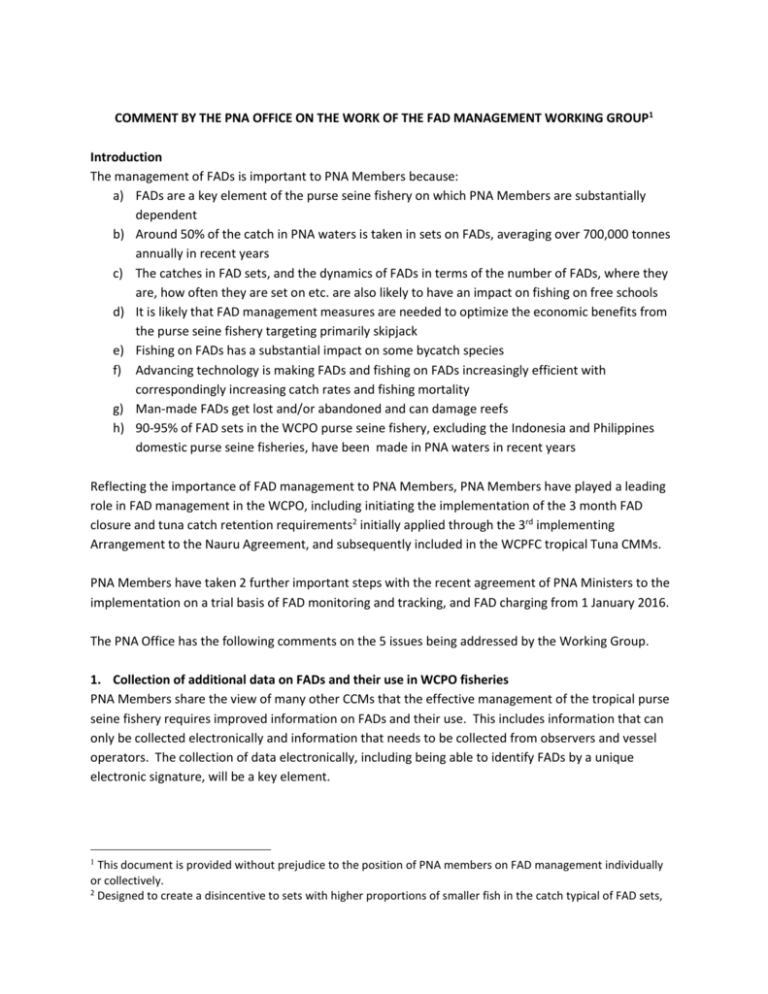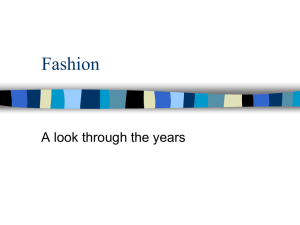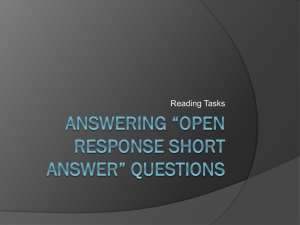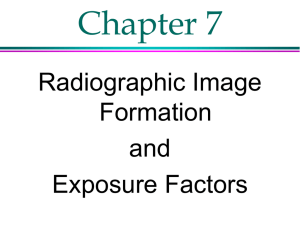waters measures
advertisement

COMMENT BY THE PNA OFFICE ON THE WORK OF THE FAD MANAGEMENT WORKING GROUP1 Introduction The management of FADs is important to PNA Members because: a) FADs are a key element of the purse seine fishery on which PNA Members are substantially dependent b) Around 50% of the catch in PNA waters is taken in sets on FADs, averaging over 700,000 tonnes annually in recent years c) The catches in FAD sets, and the dynamics of FADs in terms of the number of FADs, where they are, how often they are set on etc. are also likely to have an impact on fishing on free schools d) It is likely that FAD management measures are needed to optimize the economic benefits from the purse seine fishery targeting primarily skipjack e) Fishing on FADs has a substantial impact on some bycatch species f) Advancing technology is making FADs and fishing on FADs increasingly efficient with correspondingly increasing catch rates and fishing mortality g) Man-made FADs get lost and/or abandoned and can damage reefs h) 90-95% of FAD sets in the WCPO purse seine fishery, excluding the Indonesia and Philippines domestic purse seine fisheries, have been made in PNA waters in recent years Reflecting the importance of FAD management to PNA Members, PNA Members have played a leading role in FAD management in the WCPO, including initiating the implementation of the 3 month FAD closure and tuna catch retention requirements2 initially applied through the 3rd implementing Arrangement to the Nauru Agreement, and subsequently included in the WCPFC tropical Tuna CMMs. PNA Members have taken 2 further important steps with the recent agreement of PNA Ministers to the implementation on a trial basis of FAD monitoring and tracking, and FAD charging from 1 January 2016. The PNA Office has the following comments on the 5 issues being addressed by the Working Group. 1. Collection of additional data on FADs and their use in WCPO fisheries PNA Members share the view of many other CCMs that the effective management of the tropical purse seine fishery requires improved information on FADs and their use. This includes information that can only be collected electronically and information that needs to be collected from observers and vessel operators. The collection of data electronically, including being able to identify FADs by a unique electronic signature, will be a key element. 1 This document is provided without prejudice to the position of PNA members on FAD management individually or collectively. 2 Designed to create a disincentive to sets with higher proportions of smaller fish in the catch typical of FAD sets, PNA Members are continuing to strengthen the existing PNA Fisheries Information Management System (FIMS) including, VDS, electronic catch and effort (logsheet) reporting, electronic observer workbook reporting and FAD tracking and proximity alerting as the primary instrument for monitoring and reporting on purse seine fishing in PNA waters. Collection of additional data on FADs should be based on the same standards-based approach used for the provision of other fishery data, where the Commission defines the data to be collected as in the current Scientific Data Rules and ROP Minimum Standard Data Fields, and CCMs meet their reporting obligations in accordance with these standards. One approach would be for the Working Group to continue the work undertaken during SC9 on reviewing the requirements for reporting on FADs under the Scientific Data Rules and the ROP Minimum Standard Data Fields. 2. FAD marking, and identification, and use of electronic signatures/3. FAD monitoring, tracking and control Electronic monitoring and tracking of FADs is now an essential element of the management of the WCPO purse seine fisheries. For this reason, PNA Members will implement a trial for one year, in 2016, to register and track all FADs associated with purse seine vessels fishing in PNA waters. The trial is aimed at establishing the value for PNA Members of FAD registration and tracking for: a) Improved understanding of the use of FADs, including the numbers and types of FADs deployed, the zones they are in during the year, the patterns of use by different fleets, the numbers of FADs set on, the numbers lost or disowned and other information available from tracking and monitoring FADs etc. b) Better scientific information on the impacts of FAD and fishing on them, including: linking information on FADs and their history (FAD design, where they have been, current speeds, how often they have been set on, etc.) to information on catches from logsheets and observers to understand better how the types of FAD and their history affect catches of target species and bycatches; bycatch mitigation monitoring school structures on FADs vs free school and better monitor tagged tuna behaviour with FADs, FAD/FAD migrations providing information on how the numbers/densities of FADs in an area affect catch rates of both FAD and free school sets, which is necessary for stock assessment and for managing optimal patterns of FAD use; information on the ecosystem effects of impacts of FADs other than through catches, including entanglements and damage to reefs; oceanographic information, including sea surface temperature and currents; using biomass information, including information on fish species and sizes, from new sonar FAD buoys directly to assist in assessing stock status. c) Enhanced compliance and control, including: improved compliance in PNA waters with FAD measures (set limits and FAD closures); improved verification of “free-school” sets; ensuring industry accountability for FADs that are abandoned or wash up on reefs; tracking of FADs that enter closed areas; identifying and tracking of FADs entering PNA waters identifying efforts by vessel owners to avoid FADs being tracked; monitoring of FAD poaching and stealing activities; and verifying compliance with catch and effort reporting d) Better understanding of the economics of FAD use, including: the costs of deploying and monitoring FADs; FAD life expectancy; bio-economic impacts of FAD catches of juvenile skipjack the added economic value from FAD use; and the economic costs of measures that reduce FAD use. e) enhanced FAD management options, including: limiting the number of FAD deployed as an option to FAD closures; charging or tendering for FADs deployed or FAD time in the water. Planned features of the trial include: a) authorisation for FAD service providers to provide a parallel data stream from all drifting satellite buoys associated with vessels on the VDS Register to PNA FIMS at the same time that it is provided to the vessel operator. b) the information provided will include at a minimum: i) identification of unique FAD Buoy ID, ii) Vessel (or Vessel group) Name; iii) date and time of transmission; iv) position at time of transmission. (Lat/ Long) c) the information may also include for some buoys: i) Speed of the FAD Buoy; ii) Course/heading of the FAD Buoy; iii) Sea surface temperature; iv) Estimated biomass volume by Species detected by a Sonar Buoy. d) the information will be transmitted twice daily at dawn and dusk as well as any time polled by the buoy owner. e) vessel operators will be prohibited from setting on a FAD unless a registered buoy is attached as a condition of licence or through regulations. PNA Members look forward to working with other CCMs to develop compatible systems of tracking and monitoring FADs associated with vessels in the WCPO that are not on the PNA VDS Register. 4. FAD management options In theory, there is a wide range of options for managing FADs. In practice, from a PNA point of view, there is a more limited range of FAD management options currently appropriate to the WCPO context, where: Over 95% of FAD sets are made in the national waters of PNA Members and Indonesia and Philippines waters The purse seine fishery within PNA EEZs is managed by effort limits under the PNA purse seine Vessel Day Scheme (VDS), and FAD management in PNA waters has to complement the VDS The existing WCPFC FAD management measures, especially the FAD closure, transfer a very large disproportionate burden onto PNA Members, and any additional FAD management measures need to reduce this burden or be part of a package that reduces this burden To the extent that FAD management measures are related to bigeye conservation, any additional FAD management measures need to be associated with additional contributions to bigeye conservation from the tropical longline fishery, especially the high seas tropical longline fishery, and with longline management reform. Within this context, the PNAO considers that it will be important for the Working Group to cover the following FAD management options. FAD closure Recent SPC analysis indicates that the FAD closure is working in that it has reduced bigeye bycatches but not as much as needed or originally intended. At the same time: a) It seems clear that the effectiveness of the closure is reducing over time for a range of reasons including a shift of overall effort to the open months; an increase in the proportion of FAD sets in the open months, improvements in FAD technology being used in the open months; evasion of the closure by vessels able to operate outside the area covered by the closure, including in the EPO; and b) The closure transfers a disproportionate burden to those SIDS with substantial purse seine effort in their waters. The effectiveness of the FAD closure will be increased when the 12 month closure for the high seas is implemented. There are opportunities to improve the effectiveness of the closure through measures such as banning pre-dawn sets, controlling tender vessel operations relating to FADs and removal of FADs from the water, but these will all require to be packaged with other measures to avoid transferring further burden to SIDS. FAD charges Charging for FADs can be expected to become a more important instrument for FAD management as an incentive to fish on free schools, based on the economic effect of FAD charges in reducing FAD use. FAD charges could take several forms, including: a) A charge per (VDS) day for FAD use. This form of charge will be trialed by PNA Members in 2016 with a charge of $1,000 per VDS day for foreign vessels; b) A charge per FAD (buoy) deployed; and/or c) A charge per FAD (buoy) day in the water; In addition to these options, there are opportunities to achieve similar economic results to FAD charges through selling/auctioning FAD sets or days, or rights to deploy FADs. FAD charges aim at reducing FAD use by creating a disincentive to FAD use and an incentive to fish on unassociated/free schools. FAD charges are an alternative to the FAD closure. FAD charges appear likely to have the advantages that: a) As a market-based measure, FAD charges have less adverse impact on the overall efficiency of the fleet than blunt measures like the FAD closure because they leave vessel operators free to choose when they use FADs. This should result in reducing FAD use more at times when the impact on vessel earnings is less and reducing FAD use more by those who use them less efficiently, with lower overall reductions in fleet revenue and economic rents from reduced FAD use; b) For that reason, FAD charges can be expected to transfer a lesser burden onto PNA Members with purse seining in their waters than the FAD closure c) At the same time, FAD charges may provide a moderate revenue stream to partially compensate for the loss in revenue arising from the reduced capacity of the fleet to pay when FAD use is reduced d) FAD charges fit well with the VDS, and with PNA charges per vessel day and other forms of economic incentive that are important in the PNA approach to managing fishing in their waters e) FAD charges can easily be applied differentially to domestic and foreign vessels to promote domestic development and contribute to offsetting the burden transferred by reducing FAD use f) FAD charges can contribute to reshaping the fleet in the direction of reducing bycatches associated with FADs by deterring vessels that are highly dependent on FAD sets, especially if current low tuna prices are sustained. PNA Members look forward to working with other Commission Members on the further development of FAD charges and measures compatible with FAD charging in the tropical purse seine fishery. Limits to FAD (Buoys) Deployed Limiting the number of FADs deployed might be important for optimising the value of the purse seine fishery overall and for limiting bycatches. Limits could be applied as allocations across the fleet, including through auctioning, or as limits for individual vessels. At present, there is a lack of information for assessing whether FAD deployment limits will be useful, and what any limits should be. Gathering the information needed to address the issue of FAD limits is an important objective of the PNA FAD tracking and monitoring programme. FAD Design FAD design standards are needed for the WCPO that address: a) Avoiding entanglement: the Scientific Committee should be asked to advise on standards to avoid entangling marine life b) FAD visibility; all FADs should be clearly marked with the name and identification number of the vessel deploying them. FADs need to be easily visible for navigation safety and visibility to observers; FADs and FAD buoys should not be submersible. FAD Recovery and Liability Vessel operators should be responsible for the recovery of all FADs deployed and should be responsible for the costs of any damage caused by FADs including damage to reefs. 5. Advise on options for FAD marking and monitoring for WCPO wide application. See discussion above.








